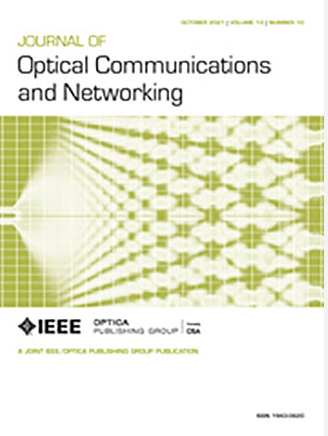时分复用QKD网络的离线调度研究
IF 4.3
2区 计算机科学
Q1 COMPUTER SCIENCE, HARDWARE & ARCHITECTURE
引用次数: 0
摘要
量子密钥分发(QKD)与量子安全加密算法相结合,为实现面向未来的通信安全提供了一条实用的途径。目前,BB84 QKD协议已经成熟,可以使用商业产品在传统光纤基础设施上部署,并使用可信密钥中继作为其距离限制的解决方案。然而,设计具有成本效益的QKD网络对于最终用户和电信运营商(Telcos)的广泛采用至关重要。为了应对这一挑战,我们提出并研究了一种新颖的策略,据我们所知,QKD收发器的周期性分时。该策略允许以先验确定的确定速率为节点对生成密钥,特别是在低、中等工作负载下节省成本。这项工作提出了一种离线解决方案,用于分配和调度QKD收发器,这些收发器在QKD网络中由上述时分多路复用(TDM)方案共享。我们提出了一种基于混合整数线性规划(MILP)的调度(MBS)方法来解决这个问题,即使对于小型网络拓扑,计算成本也很高。作为替代方案,我们引入了分配驱动调度(ADS),该算法在内部将问题分为两个步骤:先分配,后调度。调度可以通过松弛的mbs (rMBS)或循环调度(RRS)方法(分别为ADS-rMBS和ADS-RRS)来处理。这两种方法产生的结果与小型网络的MBS相当。此外,模拟表明ADS-rMBS和ADS-RRS都支持按增长付费模型,从而减少了低负载场景下的初始资本支出。与非时分复用基线(即,QKD收发器是非共享的)相比,节省的成本从30%到50%不等,使QKD部署更具经济可行性。此外,ADS-rMBS总体上优于ADS-RRS,但需要更高的运行时间,在大型网络中可达2500s。相反,ADS-RRS在所有条件下都保持稳定的1毫秒运行时,这使得两种方法根据流量矩阵更新间隔都是可行的。本文章由计算机程序翻译,如有差异,请以英文原文为准。
On offline scheduling for time-division multiplexing QKD networks
Quantum key distribution (QKD) combined with quantum-safe encryption algorithms offers a practical path to future-proof communication security. Currently, the BB84 QKD protocol is mature and can be deployed over legacy optical fiber infrastructure using commercial products, with trusted key relaying as a workaround for its distance limitations. However, designing cost-effective QKD networks is essential for widespread adoption by end users and telecom operators (Telcos). To address this challenge, we propose and study a novel, to our knowledge, strategy: periodic time sharing of QKD transceivers. This strategy, especially cost saving at low and medium workloads, allows for generating keys for pairs of nodes at deterministic rates decided a priori. This work presents an offline solution for allocating and scheduling QKD transceivers that are shared by the aforementioned time-division multiplexing (TDM) scheme in a QKD network. We propose a mixed-integer linear programming (MILP)-based scheduling (MBS) method to solve this problem, which is computationally expensive, even for small network topologies. As an alternative, we introduce allocation-driven scheduling (ADS), an algorithm that internally breaks the problem into two steps: allocate first and schedule later. The scheduling can be handled by either a relaxed-MBS (rMBS) or a round-robin scheduling (RRS) approach (ADS-rMBS and ADS-RRS, respectively). Both methods yield results comparable to MBS for small networks. Furthermore, simulations illustrate that both ADS-rMBS and ADS-RRS enable a pay-as-you-grow model, reducing the initial capital expenditure in low-load scenarios. Compared with the non-TDM baseline (i.e., QKD transceivers are non-shared), the cost savings range from 30% to 50%, making QKD deployment more economically viable. Moreover, ADS-rMBS generally outperforms ADS-RRS, but requires a higher runtime, reaching up to 2500 s in large networks. Conversely, ADS-RRS maintains a stable 1 ms runtime across all conditions, making both approaches viable depending on the traffic matrix update interval.
求助全文
通过发布文献求助,成功后即可免费获取论文全文。
去求助
来源期刊
CiteScore
9.40
自引率
16.00%
发文量
104
审稿时长
4 months
期刊介绍:
The scope of the Journal includes advances in the state-of-the-art of optical networking science, technology, and engineering. Both theoretical contributions (including new techniques, concepts, analyses, and economic studies) and practical contributions (including optical networking experiments, prototypes, and new applications) are encouraged. Subareas of interest include the architecture and design of optical networks, optical network survivability and security, software-defined optical networking, elastic optical networks, data and control plane advances, network management related innovation, and optical access networks. Enabling technologies and their applications are suitable topics only if the results are shown to directly impact optical networking beyond simple point-to-point networks.

 求助内容:
求助内容: 应助结果提醒方式:
应助结果提醒方式:


